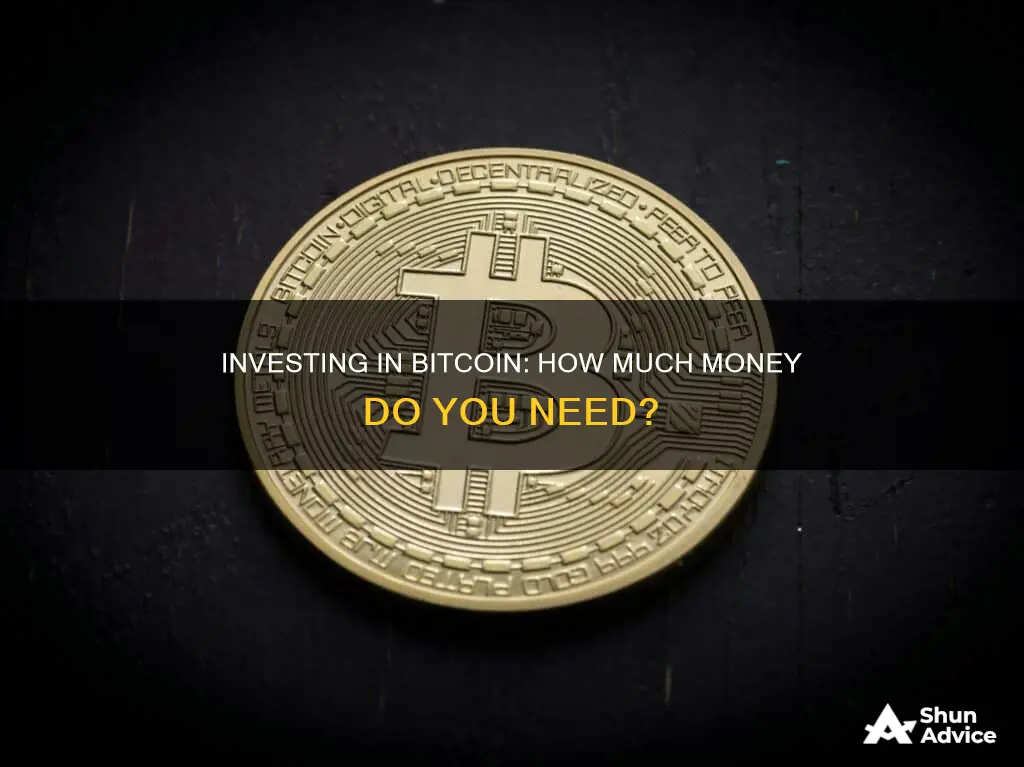
Bitcoin has become an increasingly popular investment option, especially for younger generations. However, it is important to note that it is a highly volatile and risky investment. Before investing in Bitcoin, it is crucial to understand the risks and potential rewards.
Bitcoin is a cryptocurrency, a digital asset that is created and exchanged using cryptographic computer networking technology. It can be purchased through cryptocurrency exchanges, traditional stockbrokers, money transfer apps, Bitcoin ATMs, and Bitcoin exchange-traded funds (ETFs).
When considering how much to invest in Bitcoin, it is generally recommended to invest no more than 10% of your income or portfolio in high-risk assets like cryptocurrencies. It is also important to diversify your investments and not put all your money into Bitcoin.
Additionally, it is crucial to have a secure storage solution for your Bitcoin, such as a hot wallet or a cold wallet, to protect your investment from theft or loss.
While Bitcoin has the potential to provide significant returns, it is important to carefully assess your financial situation, conduct thorough research, and understand the risks before deciding how much to invest.
| Characteristics | Values |
|---|---|
| Minimum investment | $10 or less |
| Recommended investment | 10% of your income |
| Investment platforms | Robinhood, Coinbase, Kraken, Gemini, Crypto.com, Webull, TradeStation, Fidelity, PayPal, Binance |
| Payment methods | Bank account, debit card, credit card |
What You'll Learn

Bitcoin wallets and cryptocurrency exchanges
There are two main types of Bitcoin wallets: hot wallets and cold wallets. Hot wallets are connected to the internet, making them more vulnerable to hackers but also more convenient for frequent transactions. Examples of hot wallets include apps on devices such as computers, phones, or tablets, as well as web or browser-based wallets. On the other hand, cold wallets are offline devices that are not connected to the internet, providing an added level of security but making transactions slower. Examples of cold wallets include hardware wallets (e.g., USB drives) and paper wallets (e.g., printed private and public keys on paper).
When choosing a Bitcoin wallet, consider factors such as security, ease of use, supported currencies, transaction fees, and compatibility with other wallets or exchanges. It is also important to prioritize the safe storage of your private keys and backup methods in case of loss or theft.
In addition to wallets, cryptocurrency exchanges are platforms where you can buy, sell, and trade cryptocurrencies. Examples of popular cryptocurrency exchanges include Coinbase, Kraken, Gemini, Binance, and Crypto.com. When choosing an exchange, consider factors such as security, fees, the number of supported currencies, and whether it is centralized or decentralized. Some exchanges may also offer additional features such as peer-to-peer trading, decentralized finance (DeFi) tools, or non-custodial wallets, where you have direct access to your crypto and private keys.
A Guide to Investing in Bitcoin from China
You may want to see also

Traditional stockbrokers
When choosing a platform, it is important to consider the minimum investment requirements and the reputation of the platform. Smaller or newer platforms may present security or liquidity risks. It is also important to weigh your storage options and decide how much to invest.
Bitcoin is a very high-risk investment due to its volatile nature. Its value may rise or fall dramatically in a very short period. Therefore, it is crucial to understand your risk tolerance and investment strategy before investing in Bitcoin. Some experts recommend limiting your investment in Bitcoin to under 5% of your net worth.
In conclusion, while it is possible to invest in Bitcoin through traditional stockbrokers, it is important to carefully consider the risks and potential rewards before investing in this highly volatile asset.
Investing in Bitcoin Miner: How Much Capital Is Required?
You may want to see also

Money transfer apps
Investing in Bitcoin can be a risky move, so it's important to carefully consider your goals and strategies before you decide. A common rule of thumb is to invest no more than 10% of your portfolio in individual stocks or risky assets like Bitcoin.
If you're looking to get into the world of cryptocurrency, there are several money transfer apps that can help you buy, sell, and store Bitcoin. Here are some of the most popular options:
Cash App
The Cash App allows you to send and receive Bitcoin instantly and for free. You can send Bitcoin to any $cashtag or another Lightning-compatible wallet. The app also lets you send Bitcoin using the Lightning Network or the Bitcoin Network. It's important to note that Cash App may charge a small fee when you buy or sell Bitcoin, and there are weekly and monthly limits on transactions.
PayPal
PayPal is a well-known payment processor that enables you to buy Bitcoin in two ways. You can connect your PayPal account to a debit card or bank account, or use your PayPal balance to purchase cryptocurrencies from a third-party provider. PayPal also allows you to buy and hold four types of cryptocurrencies: Bitcoin, Ethereum, Litecoin, and Bitcoin Cash. Additionally, you can use your crypto to purchase products and services through the "Checkout with Crypto" feature. However, it's important to note that PayPal earns money from the crypto spread and charges a transaction fee for each purchase.
Venmo
Venmo is another popular peer-to-peer money transfer app that allows users to purchase, store, send, and sell Bitcoin directly through the app.
Crypto.com
Crypto.com is a cryptocurrency exchange where you can purchase Bitcoin and other cryptocurrencies. It offers a variety of features and consumer protections, so be sure to do your research before choosing this platform.
Swapin
Swapin is a non-custodial provider that allows you to buy, sell, or pay with crypto in minutes. It supports high transaction volumes and offers fast payments between crypto and bank accounts. Swapin never holds your funds, ensuring a secure and convenient experience.
When using these apps, it's important to remember that there may be fees, taxes, and other charges associated with buying, selling, or transferring Bitcoin. Always review the terms and conditions carefully before making any transactions. Additionally, consider using a hot wallet or a cold wallet to store your Bitcoin securely.
Strategic Investments to Make Before the Next Bitcoin Halving
You may want to see also

Bitcoin ATMs
To use a Bitcoin ATM, you will need a cryptocurrency wallet, which is where the Bitcoin is stored. You can then insert cash or a debit card to exchange your traditional currency for Bitcoin. The amount of cash you insert will be exchanged for Bitcoin at the current market rate and sent to your digital wallet.
Some Bitcoin ATMs are bidirectional, meaning you can also sell Bitcoin at them. In this case, you enter the amount of Bitcoin you want to exchange for cash, and the ATM will dispense your money.
There are a few things to keep in mind when using Bitcoin ATMs. First, they may require you to have an existing account with the Bitcoin ATM operator. Second, they can charge high transaction fees, so it's important to research potential fees before using one. Finally, they can be a target for scams, so it's important to only send money to people you know and trust.
The Bitcoin Investment Dilemma: Worth the Risk?
You may want to see also

Bitcoin exchange-traded funds
How Bitcoin ETFs Work
ETFs are traded on stock exchanges, providing investors with diversified exposure to various asset classes. Instead of holding a variety of stocks, an investor can simply own shares of one ETF that is invested in those companies.
A futures contract is a standardised contract where two parties agree to exchange a specific quantity of a standardised asset on a specific day for a particular price. Bitcoin futures contracts are traded on the Chicago Mercantile Exchange.
A Bitcoin ETF is an exchange-traded fund that holds Bitcoin futures contracts. These ETFs are created by purchasing futures contracts and bundling them into a fund. The company then offers shares of the fund to investors. The futures contracts in the fund are actively managed while the shares are trading.
History of Bitcoin ETFs
The first concept for a Bitcoin ETF emerged when investors and brokers noticed that Bitcoin prices were trending upwards and gaining popularity. As Bitcoin's price rose, retail and average investors lost the opportunity to invest directly in Bitcoin. Brokerages began to design Bitcoin exchange-traded funds, and applications with the Securities and Exchange Commission (SEC) for approval started in 2013.
The first official Bitcoin-linked ETF was the ProShares Bitcoin Strategy ETF (BITO), approved by the SEC in October 2021 and listed on the New York Stock Exchange.
Goals of Bitcoin ETFs
Bitcoin futures ETFs are designed to allow more people to invest in Bitcoin without the necessary expenses and hassles of buying them directly. They eliminate the need for security procedures and excessive funds while providing a familiar investment type.
Limitations of Bitcoin ETFs
There are also some downsides to investing in Bitcoin futures ETFs. One limitation is tracking error, which refers to the discrepancy between the performance of the ETF and the actual price movement of the underlying Bitcoin futures. This can be due to management fees, transaction costs, or logistical issues in replicating the prices of a security.
Other limitations include regulatory uncertainty, market and ETF liquidity, the rolling of futures contracts, and cybersecurity risks.
Investing in Bitcoin ETFs
If you're looking to invest in Bitcoin futures ETFs, you can purchase them through your broker or advisor if they offer them. Many Bitcoin futures ETFs trade on exchanges such as the New York Stock Exchange ARCA and Nasdaq.
Examples of Bitcoin futures ETFs include:
- ProShares Bitcoin Strategy ETF (BITO)
- Valkyrie Bitcoin and Ether Strategy ETF (BTF)
- VanEck Bitcoin Strategy ETF (XBTF)
- Global X Blockchain & Bitcoin Strategy ETF (BITS)
The Ultimate Guide to Investing in Bitcoin Cash
You may want to see also
Frequently asked questions
You can invest any amount of money in Bitcoin, as it can be traded as fractional shares. However, it's important to remember that Bitcoin is a risky investment, so it's recommended that you only invest money that you are willing to lose.
To invest in Bitcoin, you need to set up an account with a cryptocurrency exchange, such as Coinbase, Kraken, Gemini, or Binance. You will also need personal identification documents, a secure internet connection, and a method of payment. Once you have set up your account, you can place an order to buy Bitcoin.
There is no definitive answer to this question, as it depends on your financial situation and risk tolerance. However, it's generally recommended that you invest no more than 10% of your portfolio in risky assets like Bitcoin. It's also important to remember to only invest money that you can afford to lose.







